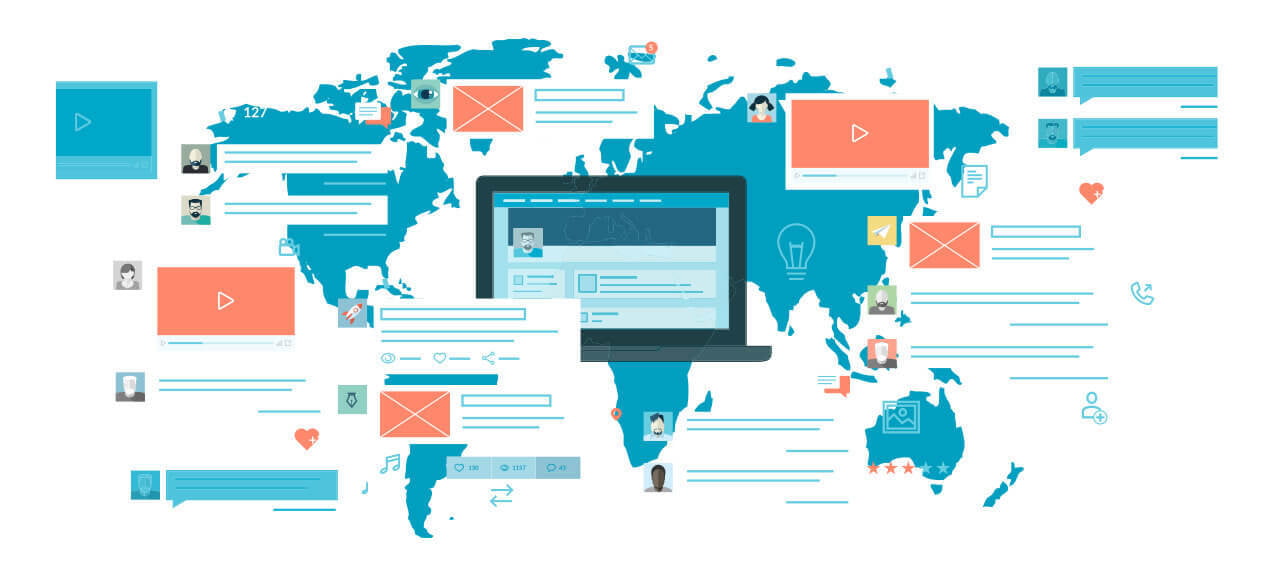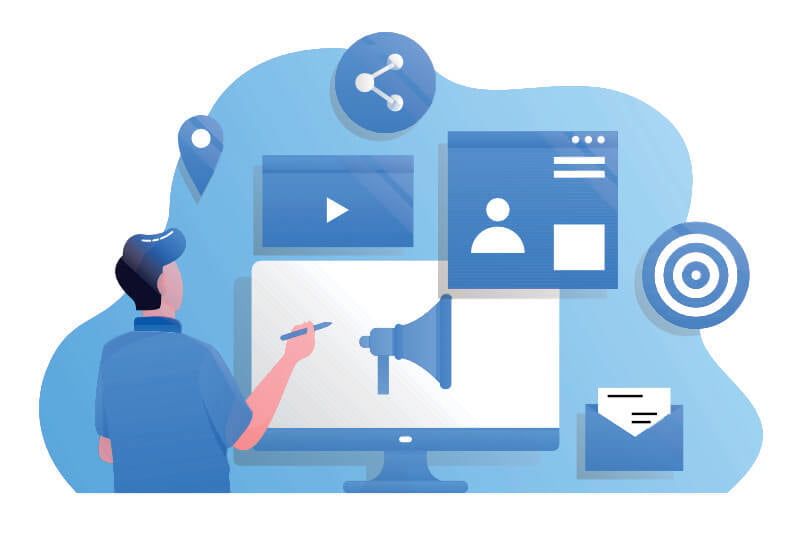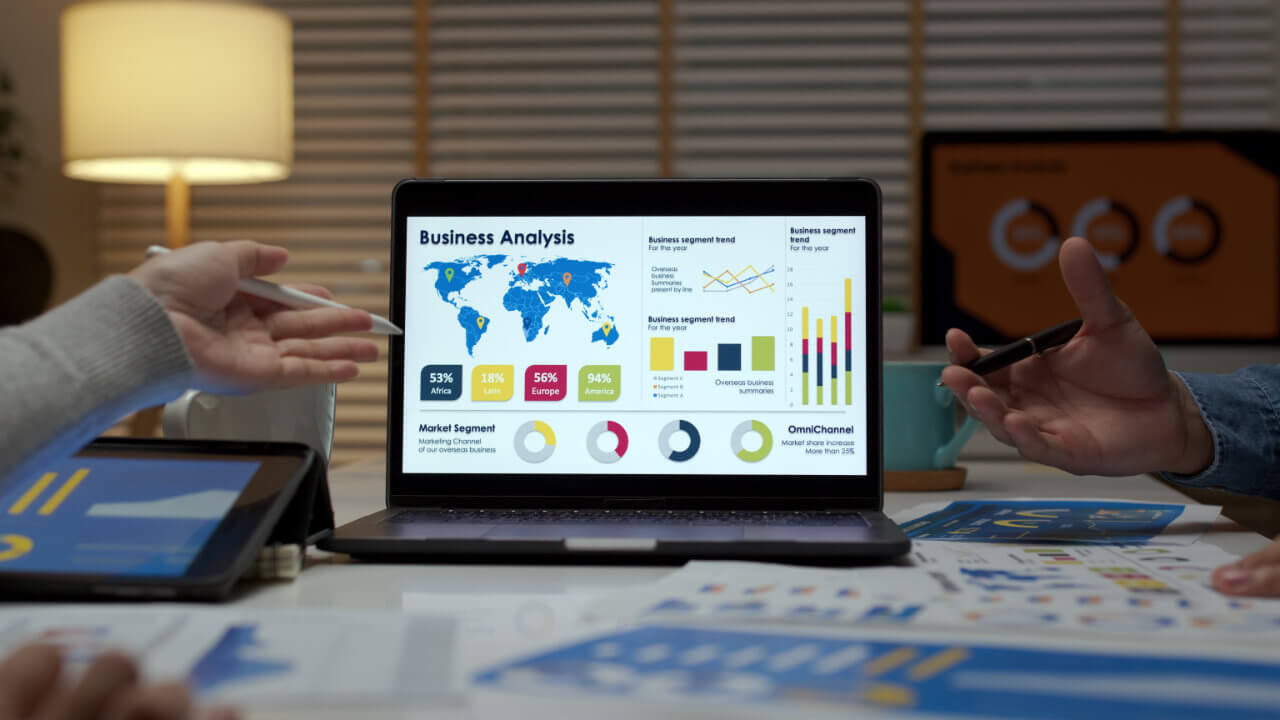
Are you spending hours creating world-class content, only to hit the publish button, and nobody sees it? Even the most well-produced content will fail to receive readership and recognition without a great content distribution strategy. Content distribution involves both paid and unpaid strategies. Establish who and where your target audience is and determine a strategy that engages them based on their wants and needs. This in-depth article will equip you with the knowledge you need to distribute content effectively so that you're getting content in front of the right people.
What is Content Distribution?
What is Content Distribution?
Content distribution is how the content will be delivered to your audience for consumption through various media formats and channels. There are many content distribution channels to share the content you create. The channels used to distribute your content depend on your audience and resources. This includes three types of channels, owned, earned, and paid media.
Owned Content Distribution
Owned Content Distribution
Owned channels are properties of content owned by your company. You can control how and when content is published on your own channel. These include your social media, blog and website, email newsletters, or mobile publishing applications.
Earned Content Distribution
Earned Content Distribution
Earned channels are when third parties promote or share your content. These third parties may include clients, journalists, bloggers, and anyone who shares your content for free, hence the "earned" name. These channels include PR, social media and mentions, guest articles and highlights, and product reviews. These also include forums and communities such as Quora or Reddit. Although posting on these sites is free, the content is owned by these third parties and thus falls under earned channels.
Paid Content Distribution
Paid Content Distribution
Paid channels are when your business pays to distribute your content through specific channels. This primarily includes pay-per-click (PPC), paid social media advertising, and paid influencer content.
Pay-Per-Click (PPC) Ads
Pay-Per-Click (PPC) Ads
The advertiser pays when people interact with his ad through impressions or clicks with pay per click. Pay per click falls under Search Engine Marketing (SEM), and if done right, it helps you get quality leads. PPC ads are most commonly found on search engine results pages (SERPs) and social media. With an SEO strategy, PPC advertising can become an integral part of your inbound marketing efforts. One of the best platforms for PPC is Google Ads.
Sponsored Content
Sponsored Content
Sponsored content is promotional material paid for by advertisers, created and distributed by other people, brands, influencers, or publishers. Sponsored content works incredibly well, especially when it includes people or brands that have already served your audience and thus already align well with your brand. As a result, sponsored content often feels natural rather than aggressive or disruptive. There are many ways to use sponsored content, including images, videos, podcasts, social media, and anything from influencers.
Paid Influencer Content
Paid Influencer Content
Paid influencer marketing requires you to hire the best content creators in your business niche to help you increase brand awareness, traffic, and conversions between your general target audience and your target audience. Influencer marketing is effective because it focuses on powerful strategies such as word-of-mouth marketing and social proof that today's shoppers may find more reliable and trustworthy than the marketing a business does for itself. Brands are projected to spend up to $15 billion on influencer marketing by 2022.
Paid Social Ads
Paid Social Ads
Paid social advertising may include PPC advertising, sponsored content, or influencer content. This form of advertising is a way to share your posts and marketing campaigns on social media platforms like Facebook, LinkedIn, and Instagram, targeting specific secondary audiences on those platforms. PPC ads, branded or influencer-generated content, and display ads are all examples of paid social networks. A paid social media strategy will most likely include tools specific to certain social media channels to create, schedule, and distribute ads to reach your target audience. Often these ads have hyper-specific ways to target your audience. For instance, Facebook lets you target by demographics and psychographics. These include data points like age, income, gender, education level, and interests.

Why Create A Content Distribution Strategy?
Why Create A Content Distribution Strategy?
There are many reasons to produce a content distribution strategy. Building one takes time, and it's important to be clear on why you're doing this in the first place.
Increase share
Increase share
The two fastest ways to get shares are to improve the quality and engagement of the content. Virality occurs when the content is so good that it's worth sharing with others. Think about producing content with a "wow factor." Will your content be so good that it blows your audience away? If the content is educational, make it incredibly in-depth and engaging. Users, everything at your disposal to make it easy to understand and share, like adding infographics, memes, videos, charts, etc.
Drive more traffic
Drive more traffic
When the audience resonates with your content, it's likely to spread. All platforms will favor your content if readers enjoy it. Increased engagement on social media posts leads to more followers and more people who discover your content. Comparatively, Google will increase your rankings when more people are spending longer on your site and engaging with your content. The increased traffic allows for greater traffic.
Higher conversions
Higher conversions
Forging relationships is a great way to increase conversions. Consumers like to purchase from people they trust. Someone seen as the go-to expert of a field doesn't struggle with conversions because most consumers are willing to pay them their full price to solve their problems. Demonstrate the value you bring to the market with your high-quality content.
Steps to Building the Perfect Content Distribution Strategy
Steps to Building the Perfect Content Distribution Strategy
Follow these steps to build a robust content distribution strategy to grab your audience's attention and bring them into your sales process.
Step 1: Define your target audience
Step 1: Define your target audience
Knowing your ideal audience and where they like to hang out online allows you to strategize the best marketing channel to distribute your content. Let's say your audiences are operations managers or chief investment officers; they might be spending their time on LinkedIn or Google compared to other social platforms. Here are questions to get you started.
Why should people read your content?
Why should people read your content?
Determine what your content marketing goal is. Does it serve to drive traffic to the website, build brand awareness, improve engagement, or generate leads? For example, do you want to increase your newsletter subscriptions or purchases on your website?
Who is your target audience?
Who is your target audience?
Determine the people you want to reach with your content. Do you want to attract existing customers or attract new ones? Would you like a younger audience to find your content and share it with their followers to raise awareness? Or do you want to target business decision-makers who are eligible to buy?
Where will your audience find your content?
Where will your audience find your content?
Identify where your ideal audience spends their time online and use your content to connect with them in the way they understand best. You can tailor your distribution strategy to reach them successfully by determining where and when they interact with content. For example, content sharing on Facebook or Twitter is more likely to reach millennials, while LinkedIn or InMail email may better fit executives and decision-makers. Now that you've answered these basic questions, you're ready to explore your content delivery options.
Research your target audience.
Research your target audience.
Content distribution is about bringing your content to your audience, not just any audience. You can't do it right if you don't know where they are and what they like to read. Before developing your strategy, research your target audience to know who will be consuming your content. Start by gathering demographic data of your website visitors, email subscribers, social media followers, and customers. Take a look at the age, gender, income, location, education, and other categories of your audience. You can extract this information from Google Analytics or social media analytics tools.
Then collect testimonials directly from your customers, email subscribers, and social media followers. Ask about their needs and thoughts on your current content and distribution efforts. Use these two data points to create buyer personas. Your buyers act as role models for ideal customers and content consumers and represent their pain points, message preferences, and motivations as you build the rest of your content delivery strategy. Use these two data points to create buyer personas. Your buyers act as role models for ideal customers and content consumers and represent their pain points, message preferences, and motivations as you build the rest of your content delivery strategy.

Define your customer persona
Define your customer persona
The basis of your offer and the key factor to its success is a perfect understanding of your customer. In marketing, this avatar of your typical customer is called a persona. Your persona needs to be a representation of your ideal customer. It should have a first name, a job, an age, and a family situation. But above all, he has values, ambitions, fears, and frustrations. You need to define your persona (s) to focus your efforts and resources on the right goal: to offer the best possible solution to your customers. For that, you need to build your personas and know their frustrations:
"I am worried about the transfer of my business";
"I'm afraid my savings will dry up at retirement";
"My information system is archaic";
"I see new entrants in my market growing faster than my business";
Keep your persona in front of you while creating content. Your content should feel like you're speaking directly at this persona character.
Step 2: Audit your existing content
Step 2: Audit your existing content
You may already host some content there, such as blog posts, videos, social media content, etc. Although your new content distribution strategy doesn't include removing such content, you should consider whether it helps or hurts your distribution efforts. Checking your current content also reminds you of what topics you've already written about and where you can learn more.
- Track your content: Use tools to track how your content is performing. For example, look at the number of traffic visitors coming from any particular blog post and check the click-through rate.
- Assess your content's impact: If you scrape your content with SEMRush, the tool will also list content length, social media, and backlinks. This data can help you assess the impact of each piece of content, alerting you to any content that needs to be updated, rewritten, or removed.
- Find content gaps: Additionally, you can discover content gaps by using the Ahrefs Content Gap tool or doing keyword research to discover new keywords or key phrases to add to your content, helping them rank higher and get more terms.
Step 3: Choose the Right Content Distribution Channels
Step 3: Choose the Right Content Distribution Channels
Your content delivery channels are probably more important than the content itself, so this step is done before creating your content and after researching your target audience. Depending on your analysis, you can post on forums and communities such as Reddit or Quora and pay to promote your content on these sites. Alternatively, you may choose to share content exclusively on social media or perhaps find that traditional PR is the best way to go. Whichever content delivery channels you choose, make sure they match your audience's preferences and behaviors. Also, be sure to optimize your proprietary distribution channels—your blog, email newsletter, and social media profiles—as they are relatively inexpensive and under your control. Even if research shows that your audience prefers social media forums or news sites to business blogs, don't ignore your assets because they reflect your brand and products. Now that you have written an interesting article for your target audience and optimized the natural referencing on the search engines, you must work on the distribution on the acquisition channels. Distribution requires at least the same amount of effort as creation. What are the different acquisition channels?
- SEO
- Social networks
- The email list
- Paid advertising
- Existing clientele recommendations
Step 4: Determine Your Content Types
Step 4: Determine Your Content Types
Step 5: Prioritize Your Content Distribution KPIs
Step 5: Prioritize Your Content Distribution KPIs
- Traffic and reach: unique page views by source and channel
- Engagement: bounce rate or the average time spent on a page
- Top content and falling content: Top page views and the top exits
- Impact: click-throughs, conversions, and backlines
- Sentiment: social shares and comments

Consider setting SMART goals for your content when choosing your KPIs.
- Specific: I'm looking to increase the organic traffic on my site by increasing backlinks from other reputable blogs. This will boost my search engine ranking and bring in more organic traffic.
- Measurable: My goal is to have 50 new backlinks this month.
- Attainable: We've already generated 20 this month, and therefore adding 30 more is feasible.
- Relevant: This goal aligned with our broader marketing plan and even boosts our earned media because we receive mentions from third-party bloggers and press outlets.
- Time-bound: I'd like to reach this target within three months.
Step 6: Content strategy: Manage your performance with the right tools
Step 6: Content strategy: Manage your performance with the right tools
Driving performance means finding the best way to achieve results. For this, you will need performance indicators:
- The engagement rate on LinkedIn
- The number of visitors to your site
- The number of subscribers to your newsletter
Your indicators should be grouped in a dashboard, updated, and checked regularly. Like this, you will not leave anything to chance!
Example:
Performance measurement indicators:
Performance measurement indicators:
- Position on Google and evolution;
- Number of new customers from the site;
- Number of visitors to the site;
- Site page conversion rate;
- Number of newsletter subscribers;
- Number of subscribers to the Youtube channel;
- Name of followers on LinkedIn.
Resources:
Resources:
- Site development and maintenance budget: 5K $ / year
- Blog budget: 10K $ / year
- Newsletter budget: 2K $ / year
- Social media budget: 5K $ / year
- SEO budget: 10K $ / year
Step 7: Content Distribution Strategy: Work on your editorial line and plan your publications
Step 7: Content Distribution Strategy: Work on your editorial line and plan your publications
At this stage, you will define the topics to be addressed in your content strategy. These topics must interest your client personas, be organized down to the millimeter, and planned overtime.
The editorial line
The editorial line
Your editorial line is simply the subjects you are going to cover, as well as how you are going to talk about them. It is a point of reference which allows you, on the one hand, to have a stock of subjects to be covered and, on the other hand, to know how you will be able to assert your brand, your values, and your uniqueness. By taking the time to define the tone and style used in your writing, you:
- Get consistency in your content;
- Retain your readers;
- You will differentiate from the competition.
Plan your publications
Plan your publications
Now that you have listed out the content, you will organize its production and distribution. The editorial calendar is the best tool for this. To plan the production, proofreading, and publication dates of your articles, you will need an efficient tool such as Trello, Notion, or Google Workspace. With a relevant editorial line, regular publications, data collection, and analysis, as well as continuous improvement of content: you create a virtuous loop with infinite potential.

Why should you start a blog to boost your content strategy (and your business)?
Why should you start a blog to boost your content strategy (and your business)?
A blog is a communication tool and is arguably the best content marketing channel universal to all businesses.
- Spreading your brand image;
- Showing your uniqueness;
- Showcasing your expertise;
- Federating a community;
- Providing answers/solutions to potential customers;
- Having your own communication space;
- Indexing your site on search engines.
The blog is certainly an excellent communication tool. But it is also an incredible weapon in terms of SEO! It allows you to position yourself effectively with keywords, answer the most searched questions on Google, and attract new potential customers! Investing in a blog by writing and distributing articles regularly over the long term will allow you to position yourself on all the subjects that revolve around your activity. It is also an excellent pretext to communicate and bring value to other acquisition channels, such as social media. The blog is also an excellent way to educate your readers, reassure them, answer their questions. As long as you know your target client well, you will be able to list all his questions and all the subjects that may interest him. Also, there are many tools allowing you to know the most searched queries on search engines.
Step 8: How to Turn Your Readers Into Prospective Clients?
Step 8: How to Turn Your Readers Into Prospective Clients?
Inbound marketing is a marketing strategy that involves attracting visitors, converting them to prospects, and then to customers. This is thanks to certain tools and certain methods. The goal of inbound marketing is to put the reader through a funnel: from discovering your content, evaluating the different options available to them, and making a decision. For this, you must set up different types of content:
- Informative content: which educates the customer and answers his questions;
- Comparative content: which helps him to know the different solutions to his problems;
- Authority content: which shows the results you have obtained on real issues.
Your challenge is twofold:
- Offer the best content;
- Give this content to the right customer at the right time.

Step 9: How to Turn Your New Prospects Into Customers?
Step 9: How to Turn Your New Prospects Into Customers?
Imagine that you now have an email list of qualified prospects, thanks to your premium content (in marketing, we call it a lead magnet). What is the next step? You have several options, depending on your typical customer. You can send them an email to thank them for downloading your content. And explain to him/her that if (s)he is interested in your services, they have the possibility of requesting a telephone appointment. This is just one example of direct prospecting. You can't necessarily make a sales proposition at this level of the famous marketing funnel. Your prospect surely needs new information, proof of your expertise, and sympathy towards your business. Content is king. At this level, the content will allow you to help your prospect decide. Thanks to your articles and your premium content, you have shown that you know how to gather the most relevant information about your theme. Now, if the prospect is qualified, he may buy your products or services - then he will have to be convinced. You have your prospect's email address. It is a real asset for your business. Some businesses sell most of their products through their email list! Because it is a way to directly address your prospects, unlike social networks where you have no control over your posts' visibility, you are sure to reach your prospective client with an email! It is essential to have an email list to not be vulnerable and dependent on a particular social network.
In any case, with the emails you have, the most important details are the following:
- Segment the different prospective clients: Not all prospects are created equal. Some are very interested in your offer; Some people need time to make a decision.
- Continue to deliver the right content to the right reader: This step can be automated with specific email sequences.
What better tool than the case study to show your value proposition?
What better tool than the case study to show your value proposition?
We strongly believe that the case study is the best way to trigger the act of buying when your prospect is interested in what you are doing. Why? The case study is about how you helped a client solve a problem. We start from an initial situation, implementing a solution until the results are obtained. Your customer's opinion is very important. It triggers a psychological phenomenon called "social proof."

Social proof is about being inspired by others to make a decision. It is a social and psychological phenomenon that affects all of us. For example, if we choose to eat in one of the two restaurants on the street, we will generally choose the one with the most people. Comparative systems and ratings are great examples of the power of social proof. When we don't know what decision to make, we base our decision on customer reviews.
By highlighting successful customer cases, you boost your credibility and your perceived value to your prospects. In our opinion, it's the best way to convert. Your prospects now have all the elements to trust you. You have greatly helped them see more clearly and show them that you have the solution to their problems.
Step 10: Retain Your Customers and Build a Long-term Relationship of Trust
Step 10: Retain Your Customers and Build a Long-term Relationship of Trust
Another point that should not be overlooked is loyalty. Having a loyal audience, client portfolio, or tribe means ensuring that you have a competitive advantage. You probably know that keeping a customer is much more profitable than trying to win a new one. Keeping a close eye on customer retention and customer lifetime value is very important for analyzing the performance of your content strategy over the long term. Trial and error can cause a lot of wasted time and money. Getting it right the first time can end up saving you a lot of money in the long run. At Universal Creative Solutions, we provide a customized solution tailor-made for your business. No cookie-cutter advice. We sit down with you and discover more about your business goals and target audience. From there, we work with you to craft an effective content distribution strategy to attract more visitors and leads to your business. We continuously analyze and optimize your results to ensure you ultimately achieve your goals. Book a consultation call with us and learn more about how UCS can help.

